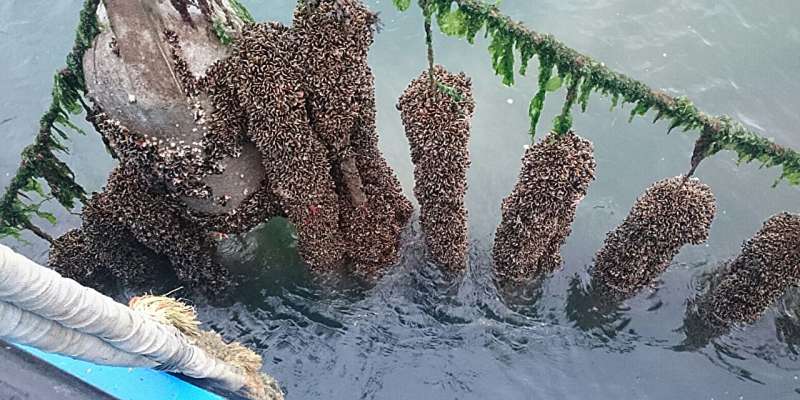This article has been reviewed according to Science X's editorial process and policies. Editors have highlighted the following attributes while ensuring the content's credibility:
fact-checked
trusted source
proofread
Fencing young mussels for ecosystem restoration

The restoration of mussel beds in the Wadden Sea or the Delta is a lot more successful when young mussels are helped a little with low, protective fences on the bottom.
That is shown by research conducted by marine biologist Jildou Schotanus at the Hogeschool Zeeland / University of Applied Sciences in Vlissingen and at the Royal Netherlands Institute for Sea Research in Yerseke. She defends her thesis, "Restoring mussel beds on highly dynamic mudflats," at the University of Groningen on Monday February 5.
Ecosystem engineers
Mussels are so-called ecosystem engineers. On large banks, mussels shape the environment to their liking. In this way, they facilitate other mussels to settle, meanwhile helping other animals and plants to find a safe place on the sea floor as well.
Moreover, mussel beds retain silt and sand and dampen the energy of waves during storms. "For this reason, there are lots of initiatives to restore mussel beds," Schotanus says. "But it is usually a daunting task."
One of the problems in restoring mussel beds is the type of mussel that is used, Schotanus explains. "In the past, adult mussels that were not used to dry conditions of intertidal mud flats were often used for this purpose. But if you suddenly try to get these mussels to settle on a mudflat that is exposed to air during low tide, where they also have to endure much more wave energy, they turn out to be unaccustomed to these conditions. Experiments we have done with very small mussels, the so-called mussel seed, show that these are still flexible enough to adapt to the rougher conditions on the tidal flats."
In another experiment, Schotanus looked at how to give mussels the best head start on the barren banks of the Oosterschelde (Eastern Scheldt). She experimented with breakwaters, with netting to keep hungry crabs away and with coir mats to help the shellfish adhere to the bottom. "All of these methods do work to some extent, but they are also very labor intensive," Schotanus says. "Relatively simple fencing that creates eddies in the currents, and can thus create lee for young mussels, seemed the most efficient in that sense."
Unaccustomed birds
One of the reasons for restoring mussel beds is to boost biodiversity. That is why Schotanus also used cameras to see how birds such as curlew and oystercatcher reacted to these strange structures on the tidal flats. "They appear to get used to them after a while," the researcher observed.
"Gulls found the larger quantities of shellfish near the fences very quickly anyway. Oystercatchers needed some time and curlews also only discovered after some time, that there were also many small crabs near the fences, which is their favorite food."
The most important lesson from her research, Schotanus thinks, is that in restoring mussel beds, you must take advantage of the positive interactions between the shellfish themselves. "Mussels simply find strength and safety in numbers. All our artificial tools have their drawbacks, so the simpler we can make it for the mussels, the better."
More information: Restoring mussel beds on highly dynamic mudflats (2024). DOI: 10.33612/diss.877010693
Provided by Royal Netherlands Institute for Sea Research





















